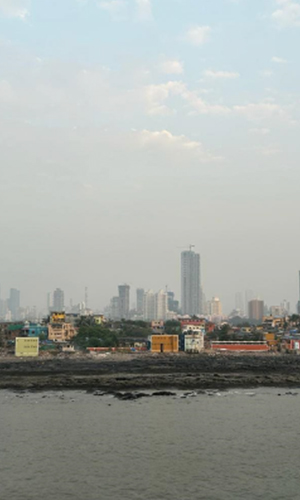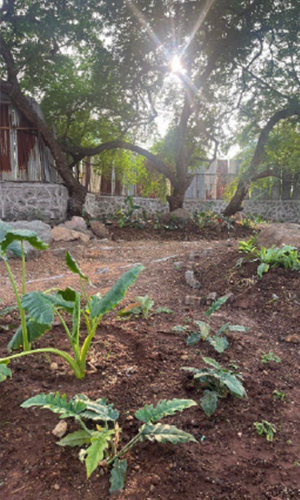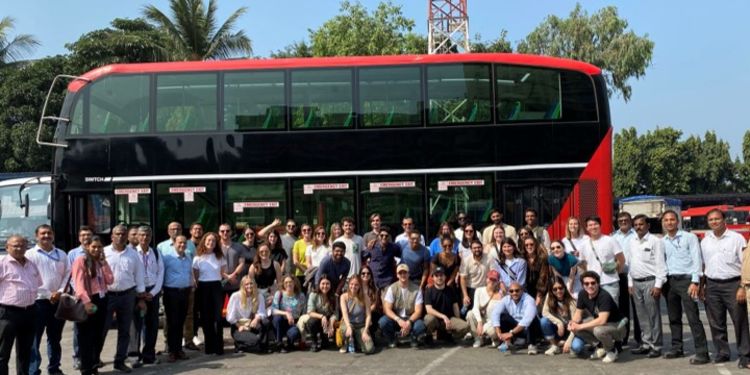Professor Vikram Gandhi’s Immersive Field Course (IFC) “Development while Decarbonizing: India’s Path to Net-Zero" delved into the critical aspect of decarbonization and sustainability goals amid India's rapid development. The course presented an opportunity for students to advance their knowledge of sustainability efforts, decarbonization, and net zero in the context of a broader development agenda. The class culminated in a series of site visits in January 2024 in Mumbai and Bangalore and this is one of 14 student essays that highlights their reflections on uncovering sustainable solutions across the country.
Urban Adaptation & Mumbai’s Climate Action Plan
By 2030, India is expected to be the third largest economy in the world with a GDP of almost $8.5 trillion. Historically, countries have relied on emissions intensive pathways towards development. As the world confronts the threats posed by climate change and aims to mitigate future emissions, India must forge a new, sustainable development pathway. This “twin challenge” of developing while decarbonizing was the main topic of our work in India. Throughout our trip, we engaged with local and international changemakers and leaders trying to answer the question: “What will it take for India to achieve a net-zero build?”
Magnifying the importance of decarbonizing India’s growth pathway is its exposure to climate change related shocks. Increased ambient temperatures, higher sea levels, and increased incidence of natural disasters all present significant risks for India’s sustained economic growth and the wellbeing of its population. As a coastal city with extensive area below sea level and already high ambient temperatures, Mumbai faces acute urban heat and flood risks and represents a case study for cities throughout India and the world in how to respond to a changing climate. Our team’s workstream focused on Mumbai’s adaptation to climate threats through the lens of the Mumbai Climate Action Plan (MCAP). Site visits and associated briefings with three partners were particularly relevant to this topic, specifically the Urban Design Research Institute (URDI), C40 Cities, and World Resources Institute (WRI) and left us with several key reflections.
Importance of Local Context

History, geography, and demography all influence the extent to which cities are impacted and respond to climate change. As discussed with URDI, it is impossible to talk about climate adaptation risks in Mumbai without looking at the city’s historical development. Mumbai was originally composed of seven distinct islands that were connected through a series of land reclamation projects beginning in the late 18th century. As sea levels rise and extreme weather events become more frequent, this historical development process has left Mumbai particularly vulnerable to climate risks. All three site visits also highlighted Mumbai’s unique demographic considerations. Approximately half of Mumbai lives in informal settlements—such as Dharavi (pictured below). These settlements have significantly higher density than the rest of the city and often lack green spaces resulting in 6-8ºC warmer heat bubbles than the surrounding neighborhoods. Urban adaptation projects that expand urban green spaces, such as the Marol Park project that we visited with WRI, can help mitigate urban heat island effects and build resiliency for vulnerable populations living in informal settlements.
Governance Structures Can Hinder or Accelerate Climate Action
The URDI team highlighted the complex web of government structures and competing administrative mandates that make urban planning particularly difficult. The first problem is that guidance on climate mitigation and adaptation at the state and federal level isn’t translated to the municipal level. The second issue is that the administrative footprint of Mumbai’s municipal government only covers part of the greater metropolitan area due to the city’s rapid growth, limiting the government’s ability to apply adaptation initiatives throughout the city. Several different operating authorities have jurisdiction over key areas. This overlap in executive authority slows down the approval of new projects and reduces coordination across initiatives. Delegating more planning authority to local wards and communities could help accelerate climate action, especially because each ward has different industrial and residential components and faces different climate challenges.

Planning is Only the First Step
One topic that came up frequently throughout our site visits was the challenges of converting planning to action. The MCAP contains ambitious mitigation and adaptation goals but lacks specific funding sources or enabling legislation. Therefore, the MCAP remains a suggestion document rather than a concrete plan for implementing mitigation and adaptation initiatives. Several speakers noted positive trends towards converting planning to action, such as the BMC’s establishment of a climate cell to coordinate implementation across departments.
Funding for Adaption Remains a Significant Challenge
As highlighted by the URDI team, funding for climate solutions would need to increase by a factor of five to achieve the mitigation and adaptation targets needed to keep warming below 1.5 degrees. Adaptation is particularly underfunded, receiving less than 10% of all funds when 20% would be required. When funding is available—either from the public or private sectors—it is typically allocated towards implementation and planning, experimentation, and monitoring tend to be underfunded as a result. These elements are critical to ensure that dollars are being allocated to the most cost-effective solutions and underscore the importance of pilot projects —such as their work in Cheeta Camp and Marol Park—to gather data on cost-effective adaptation strategies and drive future investments. Indeed, in most developing economies, there is limited local data available on climate solutions and, as highlighted above, climate adaptation projects must be locally tailored to be effective.
Potential for Global Partnerships and Collaboration
The MCAP emerged as part of a broader dialogue amongst key cities from C40’s network for collectively addressing climate change. Given the global scope of climate change, coordination across global stakeholders is essential. While every city’s pathway towards enhanced mitigation and adaptation will be shaped by its local context, C40’s scope enhances its efficacy in scaling solutions and enhancing climate action plans to address local needs. As highlighted in the MCAP, the need for partnerships extends beyond public sector entities to the private sector. Throughout our site visits, we witnessed how local (and international) corporations are promoting sustainable and inclusive projects. At BEST, Unilever, and the Godrej Group we saw firsthand how public-private partnerships can advance both critical mitigation and adaptation projects by providing financing and operational expertise.
Case Study in Adaptation: Marol Park Project
Urban heat and flooding represent Mumbai’s most significant climate risks. Temperatures are already reaching lethal levels in Mumbai. In April 2023, 11 people died following a ceremony where temperatures reached 36°C and are expected to continue to rise significantly in the coming years. Likewise, due to Mumbai’s low-lying geography approximately 35% of the population is vulnerable to flood risks and low-lying areas will generally flood 5-6 times per year. One of the most cost-effective ways of addressing both adaptation risks is expanding open and green spaces. Shaded areas can reduce summer peak temperatures by 5°C and provide benefits well beyond their local scope through more efficient air flow. Such areas also reduce flood risks by retaining water during extreme rain events. During our visit to Marol Park, a 3.2-acre urban green space that will serve approximately 172K people, we were impressed by the project's scope, which covers a wide plot in a densely populated area of Mumbai. The adjacent Mithi river has historically been controlled with retaining walls, however, in extreme flood events such structures alone are likely to be insufficient to prevent urban flooding. The permeable surfaces of parks like Marol provide additional capacity to absorb excess water and augment flood resilience while offering a public amenity for communal use outside the flood season. Once completed, the Marol Park project will provide substantial cooling and flood mitigation benefits to the surrounding area as well as a model for future adaptation projects throughout the city.
Our conversations with URDI, WRI, and C40 Cities left us aware of the many challenges facing cities like Mumbai in their fight against climate change. We were left hopeful, however, due to the strong efforts already undertaken and the potential for future action based on the results of WRI’s pilot projects.


